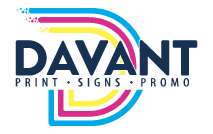FAQs
We are making it easier for you to get files to us.
In the header of the site there is an upload image (the cloud with the arrow). Click on the image and be directly linked to our uploading site.
In the footer of the site there is a linked named “UPLOAD,” click on the link and you will be directly linked to our uploading site.
If your images bleed (print all the way to the edge of the page), please add .125” bleed to your file. Include crop marks at .125” as well when including bleeds.
We prefer images that are at 300 dpi (100% size), in either JPEG or PNG files. If an image is supplied at under 300 dpi, it
will (or as close as possible), be made to 300 dpi. Be aware that if you would like an image enlarged pixelation may occur.
DO NOT supply images through Microsoft Word or PowerPoint.
Logos
Vectored logos are preferred.
Supplied logos should be provided in PDF or EPS format. Fonts within supplied files should be outlined or attached with the supplied files.
DO NOT supply a logo in JPEG or PNG files. Saving a logo as a PDF from a JPEG or PNG file will not result in the correct file form.
DO NOT supply logos through Microsoft Word, PowerPoint or Excel. Logos that have been scanned and supplied in that manner will need to be re-created.
Adobe Indesign
Under the File tab in inDesign, use the Package function to provide all images, fonts and any other links used
to build the file.
If transparency is used, please do not flatten your image.
Adobe Photoshop
Under the File tab in Photoshop, use the Package function to provide all images, fonts and any other links
used to build the file.
Files at 300 dpi (100% size) are preferred.
Adobe Illustrator Files
Under the File tab in Illustrator, use the Package function to provide all images, fonts and any other links used to
build the file. If fonts can not be provided then please outline all fonts.
If transparency is used, please do not flatten your image.
Bleeds
All files that print and have color that runs off the edge of the paper must include bleeds. These files must include at least .125” of bleed.
Cut Marks
If a file includes bleeds then cut marks will be required on the document as well. Cut marks will offset the document at .125”.
Color Bars
Color bars are not needed. We use our own color bars that are specifically calibrated to our machines.
Image files can be saved and stored in a wide variety of formats. If you are working with something you did not create, you can guess how the images file was created in terms of vector or raster by taking a look at the file format or file extension at the end of the image file name. Here are some of the more common file formats.
Vector
Basic file types – .drw (vector file), .pif (vector image GDF format), .pct (Macintosh bitmap graphics format) , .ps (Adobe PostScript), .eps (Encapsulated PostScript), .svf (Simple Vector Format).
• Adobe Illustrator – .ai
Image (Raster)
Basic file types – .jpg (JPEG raster format), .gif (GIF transparent file), .png (Portanble Network Graphic Transparent file), .tiff or .tif (Tag Interleave Format)
• Adobe Photoshop – .psd
EPS and PDF Files
Encapsulated PostScript files (.eps) are self-contained files that are the same mathematically as vector files, though they can be created from raster images as well. The format is one of the most compatible and portable because they are supported by almost all graphics software. They are an alternative to using vector files when the native formats are not available.
Adobe Portable Document Format (.pdf) files use a combination of vector and raster images. In this compact and universal format, files render as they were created. Vector images are rendered as such as and be scaled and extracted. Fonts are embedded within a file and are rendered as type, not flattened as an image element. Raster images, such as photos will appear as intended at 100 percent but will start to lose quality if they are over-enlarged.
RGB is a additive, projected light color system. All colors begin with black “darkness”, to which different color “lights” are added to produce visible colors. RGB “maxes” at white, which is the equivalent of having all “lights” on at full brightness (red, green, blue).
CMYK is a subtractive, reflected light color system. All colors start with white “paper”, to which different color “inks” are added to absorb (subtract) light that is reflected. In theory, CMY are all you need to create black (applying all 3 colors at 100%). Alas, that usually results in a muddy, brownish black, so the addition of K (black) is added to the printing process. It also makes it easier to print black text (since you don’t have to register 3 separate colors).
Screens (computer, phone, media player, television, ect) are RGB (e-ink screens being an exception), the pixels have little subpixels that just show red, green or blue.
Printers print in CMYK color (though some photo printers will print with expanded colors beyond those 4).
So if you’re ever doing something for a screen, use RGB, if you doing something for print, use CMYK.
Always keep in mind that you can’t display the exact same colors in RGB and CMYK.
Spot colors are premixed ink. It will often print more precisely than CMYK (the process color), since the CMYK color space has some limitations in the range of colors it can produce.
Sometimes CMYK colors are muddier or darker than spot, but it depends on the color. Certain colors like metallics and some pastels can’t be reproduced in CMYK and must be printed spot.
The main benefit of spot is color accuracy. This could be for a corporate color, like Coca-Cola Red or IBM Blue. Printing a color in spot, or printing it in a “double hit” (printing it once in CMYK and a second time, the same color, as a spot) can make it pop against a complex layout or on a magazine cover.
Whether you use spot or CMYK depends on your document, your color requirements, and your budget (as it could be a “fifth color” or “fifth plate” on top of the CMYK you’re already printing).
Vectored Art
For printed material the best type of file to work with is a vectored piece of art. This allows for the designer to do a magnitude of things with one piece. Whether the piece you’re working on is five inches wide or 55 inches wide, a vectored piece of art allows you to use that same piece without loosing quality in the art. This is especially important when using logos. Now, a few things to keep in mind when either making or using vector art.
What type of art works best with the project that i’m working on?
You can not take an image (jpeg and png) and convert it into either a pdf or eps file using Adobe Acrobat or Photoshop and expect for it to be a true vectored piece. Once a piece of art is rastered (see above) it must be recreated in Adobe Illustrator to be a true vectored piece.
When creating signage, brochures, booklets or any other form of art please remember to outline all font, unless edits need to be made to the file. If the fonts have been outlined please provide the fonts in the attachment or a font that closely resembles it will replace it.
Images
Using images is a great way of adding a certain characteristic to a project. It can give the piece clarity, accent colors on the piece or show what your piece means. However, it’s import to understand how to set your images, what the resolution should be to get that certain quality you’re wanting and how to save them to the right files.
Setting Your Images
When setting your images it’s important to remember to add bleeds if needed. Keep in mind that having .125″ bleeds on your images is key. If an image needs to bleed on a document and doesn’t then stretching of the image will need to be done. This will make the image larger, cause the resolution to go down and most of the time cause it to look differently then your anticipated.
Image Resolution
Getting that quality you want out of your image is all about the resolution (to an extent). When setting images for print it’s important to have a high quality image, which is 300dpi. An image is built of “pixels,” which are the small squares that can be seen when you zoom in on an image. That’s the difference between a vectored piece and an image, vector art is one solid object and images are pixelated.
It’s important to understand what happens to an image when it’s made larger. An image is made up of so many pixels, these pixels do not expand, nor do more get created when enlarged. This is why you get blurry images when you take an image that is five inches wide and expand it to 55 inches.
Saving Your Files
PDF
PDF is a file format developed by Adobe as a means of distributing compact, platform-independent documents. PDF captures formatting information from a variety of desktop publishing applications, making it possible to send formatted documents and have them appear on the recipient’s monitor or printer as they were intended.
EPS
EPS is a vector format designed for printing to PostScript printers and imagesetters. It is considered the best choice of graphics format for high resolution printing of illustrations. EPS files are created and edited in illustration programs such as Adobe Illustrator or CorelDRAW.
Vector graphics are a scalable, resolution-independent format composed of individual objects or shapes. Vector images can be resized easily without loss of quality making them an ideal format for initial logo designs and illustrations to be used in multiple sizes.
JPG
JPG is a file format best used for photo images which must be very small files, for example, for web sites or for email. JPG uses lossy compression (lossy meaning “with losses to quality”). Lossy means that some image quality is lost when the JPG data is compressed and saved, and this quality can never be recovered.
TIFF
TIFF is an industry standard designed for handling raster or bitmapped images. TIFF files can be saved in a variety of color formats and in various forms of compression. TIFFs use lossless compression to maintain image integrity and clarity and are often used for professional photography.
GIF
GIF is a file format for storing graphical images up to 256 colors. It uses a lossless compression method which makes for higher quality output. GIF files are probably the most popular on the web being used in logos and color images.
PNG
PNGs were created as a more powerful alternative to the GIF file format. PNGs are not restricted to the 256 color limitation of GIF files and have better compression. A PNG file can be saved with a transparent background which allows you to place your image on top of another image without an outlining white box.
ZIP
ZIP is a file format used for data archiving and compression. A ZIP file contains one or more files that have been compressed and bundled to reduce file size and allow for easy file transfers. ZIP files can be created by right-clicking on a file or folder and selecting “Compress” (Mac) or “Send To > Compressed/Zipped Folder” (PC). Once a ZIP file is receive (ex. via email) it must be “unzipped” or de-compressed before the files themselves can be accessed.

